European Neighbourhood Policy - South - transport statistics
Data extracted in March 2023.
Planned article update: April 2024.
Highlights
In 2021, Lebanon had the highest motorisation rate among European Neighbourhood Policy-South countries, with an estimated 392 passenger cars per thousand inhabitants, compared to 558 in the EU (2020 data).
Across the European Neighbourhood Policy-South region, from 2011 to 2021 the number of persons killed in road accidents per 100 000 inhabitants fell. The largest decreases were recorded for Jordan (-45.2 %; 2011-2018), Tunisia (-42.3 %; 2011-2020), Lebanon (-41.9 %) and Algeria (-41.6 %).
Motorisation rate, 2011, 2020 and 2021
This article is part of an online publication; it presents information on a range of transport statistics for the European Union (EU) and 8 of the 10 countries that form the European Neighbourhood Policy-South (ENP-South) region — Algeria, Egypt, Israel, Jordan, Lebanon, Morocco, Palestine [1] and Tunisia; no recent data are available for Libya or Syria. It presents information covering transport infrastructure as well as passenger and freight transport for four different modes of transport: road, rail, air and maritime.
Full article
Road transport
Table 1 measures the density of the road transport network in relation to total area, an indicator that is comparable between territories.
In 2021, Israel recorded the highest road density (all roads, including motorways) among the ENP-South countries, with 917 meters of road per square kilometre (km2) of land area. Lebanon and Palestine followed with 655 and 576 meters per km2, respectively. In Egypt and Tunisia roads were spread more thinly, at 150 and 121 meters per km2 (both 2020 data), respectively. Jordan (2020 data) and Morocco recorded similar road network densities to each other, both with 84 meters per km2. The lowest road network density among the ENP-South countries was found in Algeria, with 55 meters per km2 (2020 data). In comparison, the density of the EU’s road network was estimated at 830 meters per km2 in 2021, which was lower than that of Israel.

(meters per km2 of total area)
Source: Eurostat (road_if_roadsc), (road_if_motorwa), (reg_area), (enps_road_if) and (enps_reg_area3)
Among the ENP-South countries, car ownership is generally less common than in the EU and passenger cars tend to account for a lower share of the total number of road vehicles. Subject to data availability, Table 2 shows that Algeria had the highest total number of passenger cars among the ENP-South countries, at 4.3 million in 2020 (no 2021 data available). Morocco and Israel followed with 3.3 million each in 2021. Egypt (2017 data), Lebanon (2021 data), Tunisia (2020 data) and Jordan (2018 data) reported 3.0, 1.9, 1.4 and 1.3 million passenger cars, respectively. Palestine had a significantly lower level than the other countries with 266 thousand passenger cars in 2021.
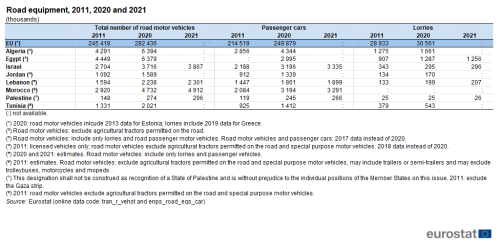
(thousands)
Source: Eurostat (tran_r_vehst) and (enps_road_eqs_car)
In 2021, passenger cars accounted for 90 % of road motor vehicles in Palestine, 86 % in Israel, 84 % in Jordan (2018 data), 83 % in Lebanon, 70 % in Tunisia (2020 data), 68 % in Algeria (2020 data), 67 % in Morocco and 47 % in Egypt (2017 data). In 2011, the share of passenger cars among the ENP-South countries was the highest in Lebanon, with 91 %. In comparison, the EU’s share was estimated to be at 88 % in 2020, with 250 million passenger cars out of 282 million road motor vehicles in total.
Algeria had the highest number of lorries, with 1.7 million (2020 data), followed by Egypt with 1.3 million in 2021. In the other ENP-South countries, the number of lorries were 543 000 in Tunisia (2020 data), 296 000 in Israel, 207 000 in Lebanon, 170 000 in Jordan (2018 data) and 26 000 in Palestine in 2021. In the EU, lorries accounted for 30.6 million road vehicles (2020 data).
The motorisation rate is measured as the number of passenger cars per thousand inhabitants. As shown in Figure 1, among the ENP-South countries, Lebanon had the highest motorisation rate in 2021, at 392 passenger cars per thousand inhabitants (2018 data for population), followed by Israel at 359. This was significantly higher than the motorisation rates for the other ENP-South countries, with 133 passenger cars per thousand inhabitants in Jordan (2018 data), 121 in Tunisia (2020 data), 99 in Algeria (2020 data) and 91 in Morocco. The lowest motorisation rate among the ENP-South countries was found in Palestine, at 51 passenger cars per thousand inhabitants. Data for Egypt is not available.
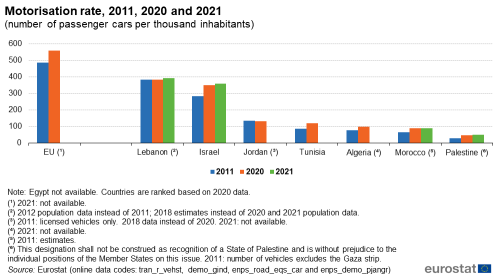
(number of passenger cars per thousand inhabitants)
Source: Eurostat (tran_r_vehst), (demo_gind), (enps_road_eqs_car) and (enps_demo_pjangr)
During the 10 year period from 2011-2021, the motorisation rate increased in all ENP-South countries for which data are available, with the exception of Jordan, which showed a decrease of 2.1 % between 2011 and 2018 (latest data available). The ENP-South country with the lowest motorisation rate in 2021 – Palestine – recorded the fastest expansion in car ownership between 2011 and 2021, with a 75.9 % increase. Over the same period, the motorisation rate in Morocco increased by 41.7 %. In Tunisia it increased by 39.4 % (2011-2020), in Israel by 26.3 % and in Algeria 26.1 % (2011-2020). The lowest growth was found in Lebanon, with an increase of 2.4 % between 2011 and 2021.
In the EU, there were 558 passenger cars per thousand inhabitants in 2020. This marked an increase of 14.5 % in car ownership from 2011, or 71 additional cars per thousand inhabitants.
Figure 2 presents information on the number of persons killed in road accidents per 100 000 inhabitants in 2011, 2020 and 2021. In this context, it should be noted that the numbers observed for 2020 may have been impacted by the Covid-19 pandemic, due to restrictions on movement in many countries and corresponding low traffic levels. This should be kept in mind when looking at recent developments in the number of persons killed in road accidents per thousand inhabitants. From 2020 to 2021, it increased in all ENP-South countries for which data is available, except in Lebanon where it decreased by 10.0 %. The highest increase was observed in Morocco, where the number increased to 10.1 fatalities per 100 000 inhabitants in 2021 (up 21.4 % compared to 2020). A similar trend was observed in Palestine (up 18.0 % to 2.6 fatalities per 100 000 inhabitants), Israel (up 17.4 % to 3.9), Algeria (up 13.8 % to 7.4) and Egypt (up 13.4 % to 7.0). Data for 2021 is not available for Tunisia and Jordan.
All ENP-South countries reported a decrease in the rate of road fatalities over the period 2011-2021. The highest fall was recorded by Tunisia, from 13.9 to 8.0 fatalities per 100 000 inhabitants (2011-2020), a reduction by 5.9 (or -42.3 %). However, as noted above, low traffic levels in 2020 due to the Covid-19 pandemic may influence the result of this comparison. The second highest reduction was recorded in Lebanon, by 5.6 to 7.8 fatalities per 100 000 inhabitants in 2021 (-41.9 %), with the third highest in Algeria, by 5.3 to 7.4 (-41.6 %). Jordan’s road fatality rate fell by 4.7 to 5.7 (-45.2 %) from 2011 to 2020; again, the change to 2020 should be looked at in the context of the low traffic levels caused by the pandemic. In Morocco, with 10.1 persons killed in road accidents per 100 000 inhabitants in 2021, the rate was 2.8 lower than 2011 (-21.7 %). Egypt’s road accident fatality rate declined by 1.9 compared with 2011 (-21.7 %). In Israel, compared with 2011 there was a drop by 1.0 to 3.9 road accident fatalities per 100 000 inhabitants in (-21.1 %), the second lowest rate among the ENP-South countries. The lowest road fatalities rate in 2021 was recorded in Palestine, with 2.6, down 0.2 compared to 2011 (-8.8 %).
In the EU, the number of persons killed in road accidents per 100 000 inhabitants in 2011 and 2020 were 6.5 and 4.2, respectively, corresponding to a decline of 35.4 % over this period (the 2020 ratio may have been affected by the Covid-19 pandemic).
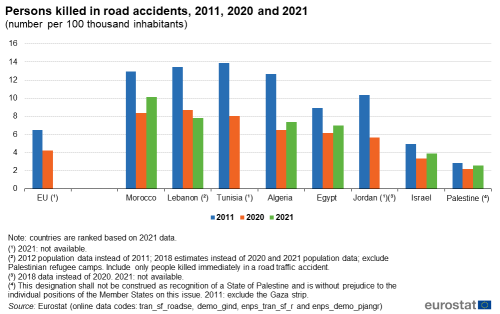
(number per 100 thousand inhabitants)
Source: Eurostat (tran_sf_roadse), (demo_gind), (enps_tran_sf_r) and (enps_demo_pjangr)
Rail transport
Passenger-kilometres (pkm) and tonne-kilometres (tonne-km or tkm) are also used for analysing transport statistics. The majority of passenger and freight transport statistics are based on movements in the reporting country, regardless of the nationality of the vehicle or vessel involved (the “territoriality principle”).
Table 3 shows rail passenger and rail freight transport measured in million passenger kilometres (pkm) and tonnes-kilometres (tkm), respectively. A rail passenger is any person, excluding members of the train crew, who makes a journey by rail. The weight of goods transported by rail is the gross-gross weight, which includes the total weight of the goods, all packaging, and the tare weight of any container, swap-body and pallets containing goods. In rail freight transport, this also includes the weight of road goods vehicles that are carried by rail. Lebanon and Palestine do not have railway activities. Jordan have only very minor railway activities.
In 2020 and 2021, rail passenger transport has been heavily impacted by the Covid-19 pandemic and the subsequent transport restrictions put in place across the world. All ENP-South countries for which data is available showed a substantial fall in rail passenger transport performance between 2019 and 2021 (or 2020, depending on data availability), except for Jordan which has only marginal rail transport. Israel recorded the sharpest decline in passenger transport by rail between 2019 and 2021, by -45.4 %. In Tunisia, rail passenger transport fell by 43.2 % from 2019 to 2020 (no 2021 data available). Algeria and Morocco also recorded large decreases between 2019 and 2021, by 24.7 % and 19.7 %, respectively. Egypt recorded the lowest decrease, by 8.2 % between 2019 and 2020 (no 2021 data available). In the EU, rail passenger transport decreased by -37.0 % from 2019 to 2021.
In Egypt, rail passenger transport in 2020 accounted for 38.6 billion passenger-kilometres, by far the highest among the ENP-South countries. Although this was 3.4 billion pkm less than in 2019, it represented an increase of 27.0 % compared to 2011 when there were 27.3 billion. In Israel, there were 2.0 billion pkm in 2021, up from 1.9 billion in 2011. In Algeria, rail passenger transport performance accounted for 1.1 billion pkm in 2021, compared to 1.0 billion in 2011. In Morocco, rail passenger transport performance decreased from 4.8 billion pkm in 2011 to 4.5 billion in 2021. However, this still represented a strong recovery from the 2.7 billion recorded in 2020. Tunisia’s rail passenger transport fell to 0.6 billion pkm in 2020, from 1.1 billion pkm in 2011. In Jordan, rail passenger transport was considerably lower than in the other ENP-South countries, with just 1 million pkm in 2018 (no more recent data available) and similar levels in 2011. In the EU, rail transport accounted for 261.5 billion passenger-kilometres in 2021, down from the pre-Covid-19 level of 415.2 billion in 2019 (data not available for 2011).
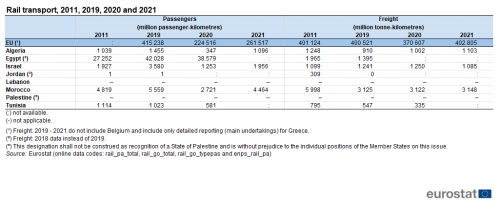
Source: Eurostat (rail_pa_total), (rail_go_total) and (enps_rail_pa)
The picture for rail freight transport is somewhat different. In 2020, rail freight transport was certainly impacted by restrictions on transport introduced to contain the Covid-19 pandemic, albeit to a much lesser extent than rail passenger transport. Israel recorded a notable fall in rail freight transport between 2020 and 2021 (-13.2 %, down from 1.3 to 1.1 billion tkm). Morocco, at 3.1 billion tkm in 2021, remained at a relatively stable level over the same period (+0.8 %), while freight transport by rail increased substantially in Algeria (up 10.1 % to 1.1 billion tkm). Data for 2021 is not available for Tunisia, but rail freight transport fell from 0.5 billion tkm in 2019 to 0.3 billion in 2020. In the EU, rail freight transport increased by 8.7 % between 2020 and 2021, reaching a slightly higher level in 2021 than in 2019 (+0.6 %).
Compared to 2011, rail freight transport was lower in all ENP-South countries for which recent data is available. In Jordan, rail freight transport ceased operating in 2018 and is currently in a transitional period; in 2011, it accounted for 309 million tkm. Among the other ENP-South countries, the highest fall in rail freight transport was recorded in Tunisia (-57.8 % between 2011 and 2020); in 2011, rail had accounted for 0.8 billion tkm of freight transport. Morocco registered the second biggest drop, from 6.0 billion tkm in 2011 (-47.5 % between 2011 and 2021). Rail freight transport in Egypt accounted for 1.4 billion tkm in 2018 (no more recent data available), down from 2.0 billion tkm in 2011 (-29.0 % between 2011 and 2018). In Algeria, rail freight transport decreased by 11.6 % in 2021 compared to 2011, when it was 1.2 billion. Algeria recorded 0.9 billion tkm in 2019, rising to 1.0 billion tkm in 2020 in contrast to the overall trend that year. Israel recorded the lowest fall between 2011 and 2021, by 1.3 % from 1.1 billion tkm in 2011. In the EU, rail freight transport increased from 401 billion tkm in 2011 to 403 billion tkm in 2021.
Air transport
Air transport statistics concern both national and international transport. As regards passenger transport, the number of passengers carried are measured; information is collected on both arrivals and departures. There has been a considerable expansion in air services in recent decades, both in terms of passenger numbers and freight carried. Although there has been rapid growth, it is worth noting that the weight of goods carried by air remains relatively low, given the high cost of this mode of transport (for example, when compared with maritime freight), in particular for bulky items.
Figure 3 shows the evolution in the number of passenger arrivals carried by air. Passengers carried include: all passengers on a particular flight (with one flight number), counted once only and not repeatedly on each individual stage of that flight; and all revenue and non-revenue passengers whose journey begins or terminates at the reporting airport, as well as transfer passengers joining or leaving the flight at the reporting airport. This measure excludes direct transit passengers.

(index 2015=100; based on passengers carried)
Source: Eurostat (avia_gooc) and (enps_avia_pa)
To contain the COVID-19 pandemic, countries around the world introduced a variety of restrictive measures in 2020. Air transport was severely affected by these measures, in particular the transport of passengers. All ENP-South countries for which data is available registered dramatic falls in air passenger transport in 2020 compared to 2019. In Israel, the number of arrivals in 2020 fell to less than one fifth of what they were the year before (-81.1 %). In Algeria and Tunisia, the number of arrivals in 2020 fell to less than one quarter of the arrivals recorded in 2019, with falls of -77.6 % and -75.6 5, respectively. In Lebanon and Morocco, the numbers of arrivals fell almost as much, falling by -72.6 % in Lebanon and -71.9 % in Morocco from 2019 to 2020. In Egypt, the number of arrivals were just over one third in 2020 compared to 2019 (-65.8 %). There is no data available for 2019 and 2020 for Jordan. In the EU, the effects of the Covid-19-related travel restrictions on air travel was similar to the effects in the ENP-South countries, with the number of air passenger arrivals falling 72.3 % from 2019 to 2020.
In 2021, a certain rebound in passenger transport by air was observed for all ENP-South countries for which data are available. Lebanon recorded the highest increase between 2020 and 2021, by 76.7 %, followed by Algeria (+ 59.4 %), Morocco (+37.4 %) and Israel (+34.8 %). Data for 2021 is not available for Egypt, Jordan and Tunisia.
When looking at the period 2011-2019, in other words before the outbreak of the Covid-19 pandemic, a steady growth in air passenger arrivals was observed in most of the ENP-South countries. The exceptions were Egypt and Tunisia where the evolution was more uneven. In particular, in 2012 a substantial increase was observed in both countries, following the Arabic Spring in 2011. In Tunisia, a large decrease was registered in 2015; the terrorist attack close to Sousse in June 2015 was probably a contributing factor. Following a steady increase in the subsequent years, by 2018 the air passenger transport in Tunisia had recovered to the level observed in the period 2012-2014, reaching a new peak in the number of arrivals in 2019. The number of air passenger arrivals in Tunisia were 51.3 % higher in 2019 compared to 2011. In Egypt, a noticeable decrease in air passenger arrivals was recorded in 2016 with a continuing low level in 2017, against a backdrop of substantial political unrest and economic turmoil.
Israel recorded the highest increase between 2010 and 2019, with the number of air passenger arrivals almost doubling (+98.1 %). In Morocco, the number of air passenger arrivals increased by 62.8 % between 2011 and 2019. In Algeria and Lebanon, arrivals increased by 60.5 % and 52.0 %, respectively. In Jordan, the number of air passenger arrivals increased by 44.7 % between 2011 and 2018 (no more recent data available). In Egypt, the number of air passenger arrivals increased by 34.5 % over the period 2011-2019 as a whole. Palestine reported zero air passengers in 2011; there is no data available for the subsequent period 2012-2021. In the EU, arrivals of air passenger increased by 40.6 % between 2011 and 2019.
Figure 4 presents the evolution in air transport of freight and mail, i.e. freight loaded or unloaded in the airports of the reporting country, between 2011 and 2021. Transport of air freight and mail was also impacted by the restrictions related to the Covid-19 pandemic, albeit to a much lesser extent than passenger transport. All ENP-South countries for which data on air freight transport is available registered substantial falls in 2020 compared to 2019. The highest fall in 2020 compared to 2019 was registered in Egypt (-36.6 %), followed by Morocco (-36.1 %), Lebanon (-26.3 %), Algeria (-23.4 %), Tunisia (-14.7 %) and Israel (-9.0 %). There is no data available for 2019 and 2020 for Jordan. In comparison, there was a drop of 9.2 % in air freight and mail transport in the EU in 2020.
In 2021, a rebound was observed for all ENP-South countries for which data are available, except for Algeria where air freight and mail transport decreased by 1.7 % compared to the previous year. Israel recorded the highest increase between 2020 and 2021, by 17.5 %, followed by Morocco (+13.8 %) and Lebanon (+5.9 %). Data for 2021 is not available for Egypt, Jordan and Tunisia. In the EU, transport of air freight and mail picked up even more strongly, with an increase of 20.7 % from 2020 to 2021.
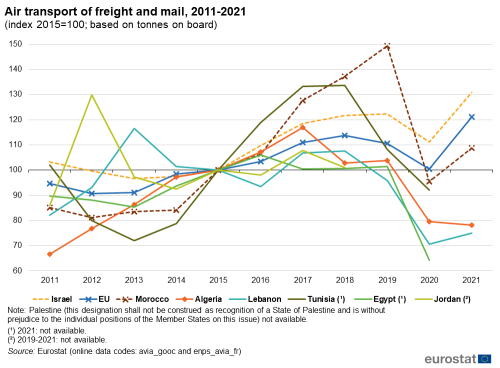
(index 2015=100; based on tonnes on board)
Source: Eurostat (avia_gooc) and (enps_avia_fr)
Over the period 2011-2021 as a whole, the quantity of air freight and mail increased in all ENP-South countries for which data are available, with the exception of Lebanon with a decrease of 8.9 %. Morocco reported the highest increase among the ENP-South countries (+27.6 %). There was almost as high growth over this period in Israel, with 26.7 %, while it was somewhat lower for Algeria (+17.2 %). For Egypt and Tunisia, air freight and mail transport increased by 13.1 % and 5.9 %, respectively, when comparing 2011 and the last year before the Covid-19 pandemic, 2019 (2021 data is not available). In Jordan, a 17.6 % increase was registered from 2011 to 2018, with no more recent data available. In comparison, the EU recorded growth of 27.9 % in air transport of freight and mail between 2011 and 2021.
Maritime transport
Figure 5 provides information on the number of maritime passengers that disembarked in each of the ENP-South countries. A sea passenger is defined as any person that makes a sea journey on a merchant ship; service staff are excluded, as are non-fare paying crew members travelling but not assigned, as well as infants in arms.
As with rail and air transport, maritime transport, in particular passenger transport, was impacted by the Covid-19 pandemic and the subsequent restrictions put in place to limit the spread of the virus. All ENP-South countries for which data is available registered dramatic falls in passenger numbers in 2020 compared to 2019. In Israel, the number of maritime passengers disembarking in 2020 was 95.7 % lower than in the previous year. In Algeria, this number fell by 89.2 % from 2019 to 2020, while in Morocco it fell by 81.8 %. In Egypt, the number of disembarking passengers fell to a third in 2020 (-66.7 %) compared to 2019, a fall that was almost matched also by Tunisia (-60.0 %). Lebanon reported no passenger transport in 2020, while there is no data available for 2020 for Jordan. The EU also experienced a sharp fall in the number of maritime passenger disembarking in its ports, with the level nearly halving (-43.2 %) between 2019 and 2020.
Data for 2021 are only available for Tunisia, Algeria and Lebanon. A large rebound was observed in Tunisia, with a recorded growth of 87.5 % compared to 2020; however, this was still not sufficient to return to the level observed in 2017, 2018 and 2019. Lebanon reported still no passenger transport in 2021, just as in 2020. Algeria reported a continued falling number of disembarking passengers also in 2021 (-11.3 % compared to 2020).
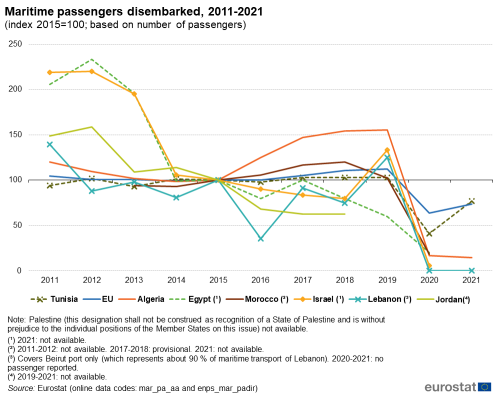
(index 2015=100; based on number of passengers)
Source: Eurostat (mar_pa_aa) and (enps_mar_padir)
Prior to the Covid-19 pandemic, in the period from 2011 to 2019, Algeria and Tunisia recorded a positive change in the number of maritime passengers of 29.5 % and 9.3 %, respectively. From 2013 to 2019 (no data available before 2013), Morocco registered a growth of 9.1 %. In contrast, Egypt and Israel showed substantial falls from 2011 to 2019 in the number of maritime passengers, of 70.8 % and 39.1 %, respectively. For Egypt, the number halved from 2013 to 2014, while for Israel it came close to halving between the same two years. It should be noted that the data for Lebanon only refer to the port of Beirut, which accounts for about 90 % of maritime transport in Lebanon. The number of maritime passengers fell also in Jordan (-10.5 %) from 2011 to 2018 (no more recent data available). In the EU, there was a growth of 7.6 % in the number of disembarking maritime passengers from 2011 to 2019.
Figure 6 illustrates the gross weight of goods handled in all ports of the ENP-South countries and the EU, respectively, relative to their population size. The weight is measured as gross weight (in other words, excluding the tare weight of any containers, but including the weight of any packaging) for maritime freight transport.
The maritime freight transport was certainly also impacted by the restrictions related to the Covid-19 pandemic, albeit to a much lesser extent than the maritime passenger transport. All but one of the ENP-South countries for which data is available registered a fall in the gross weight of goods handled, relative to their population size, from 2019 to 2020. The exception was Tunisia, where an increase of 0.9 % was observed. The highest fall in 2020 compared to 2019 was registered in Lebanon (-30.5 %), followed by Algeria (-13.0 %), Morocco (-11.2 %), Egypt (-4.1 %) and Israel (-2.3 %). Data for Jordan are only available up to 2018. In the EU, there was a drop of 7.5 % in maritime freight transport (in tonnes per inhabitant) from 2019 to 2020.
In 2021, a rebound was observed for all ENP-South countries for which data are available, with the exception of Morocco. In Morocco, maritime freight (in tonnes per inhabitant) decreased by 1.5 % in 2021 compared to 2020. Tunisia recorded the highest increase by 6.3 %, followed by Algeria (+3.1 %), Lebanon (+2.5 %) and Israel (+2.4 %). There is no 2021 data available for Egypt and Jordan. In the EU, maritime freight recovered by 4.1 %.

(tonnes per inhabitant)
Source: Eurostat (mar_mg_aa_cwh), (enps_mar_frdir) and (enps_demo_pjangr)
Among the ENP-South countries, Israel had the highest quantity of goods handled in ports relative to its population, at 6.4 tonnes per inhabitant in 2021, which was considerably more than the quantities recorded for Morocco and Algeria, both at 2.5 tonnes per inhabitant in 2021. Over the period 2011-2021 as a whole, Israel reported a total increase of 9.8 %. A shorter time series is available for Morocco, which recorded an increase of 10.8 % from 2013 to 2021 (no previous data available). In contrast, Algeria recorded a 22.9 % decrease 2011-2021. The weight of goods handled in Tunisian ports was 2.1 tonnes per inhabitant in 2021, up from 1.9 in 2011 (a 9.5 % growth). In Lebanon, the weight of goods per inhabitant was estimated at 1.0 in 2021 (2018 population data used instead of 2021 for the calculation), showing a decrease by 45.7 % from 1.8 in 2011 (2012 population data used). In Egypt, the weight of goods per inhabitant decreased by 3.0 % between 2011 and 2020, with 1.6 tonnes per inhabitant in 2020 (no 2021 data available). Jordan’s ports reported a substantial decline in the weight of maritime freight handled from 3.1 tonnes per inhabitant in 2011 to 1.6 tonnes in 2018 (no more recent data available). This represents a 49.0 % decline over this period. In comparison, the weight of freight handled in EU ports was 7.7 tonnes per inhabitant in 2021, corresponding to an overall increase of 4.1 % when compared with 2011, when the EU recorded 7.4 tonnes per inhabitant.
Source data for tables and graphs
Data sources
Data for ENP-South countries are supplied by and under the responsibility of the national statistical authorities of each country on a voluntary basis. The data presented in this article result from an annual data collection cycle that has been established by Eurostat. No recent data are available from either Libya or Syria. These statistics are available free-of-charge on Eurostat’s website, together with a range of different indicators covering most socio-economic areas.
For the EU, transport statistics are available with an annual frequency and generally begin in the early 1990s. Eurostat’s statistics describe the most important features of transport, not only in terms of the quantities of freight and numbers of passengers that are moved each year, or the number of vehicles and infrastructure that are used, but also the contribution of transport services to the economy as a whole. Data collection is supported by several legal acts obliging the EU Member States to report statistical data (framework legislation and implementing legislation, organised according to the mode of transport under consideration), as well as voluntary agreements to supply additional data.
Passenger transport statistics
The majority of passenger transport statistics are based on vehicle movements in each of the reporting countries, regardless of the nationality of the vehicle or vessel involved (the ‘territoriality principle’). For this reason, the measure of passenger-kilometres (pkm, which represents one passenger travelling a distance of one kilometre) is generally considered as a more reliable measure, as a count of passengers entails a higher risk of double-counting, particularly for international transport. A rail passenger is any person, excluding members of the train crew, who makes a journey by rail.
Freight transport statistics
As with passenger transport statistics, freight transport statistics are generally based on movements in each reporting country, regardless of the nationality of the vehicle or vessel involved (the ‘territoriality principle’). For this reason, the measure of tonne-kilometres (tkm or tonne-km, in other words, one tonne of goods travelling a distance of one kilometre) is generally considered a more reliable measure when analysing freight transport statistics, as the simple use of tonnes entails a higher risk of double-counting, particularly for international transport.
Transport safety
Eurostat publishes transport safety data for road, rail, inland waterways, maritime and air transport. CARE is the European centralised database on road accidents which result in death or injury across the EU, developed on the basis of Council Decision 93/704/EC; it is managed by the Directorate-General for Mobility and Transport. A road death is defined as the number of deaths that are caused by road accidents and which occur within 30 days from the date of the accident; the count includes drivers and passengers in motorised vehicles and on bicycles who might be involved in road accidents, as well as pedestrians.
Tables in this article use the following notation:
| Value in italics | data value is forecasted, provisional or estimated and is therefore likely to change; |
| : | not available, confidential or unreliable value; |
| – | not applicable. |
Context
An efficient and well-functioning passenger and freight transport system is vital for enterprises and inhabitants. The ability to move goods safely, quickly and cost-efficiently to markets is important for international trade, national distributive trades, and economic development. The rapid increase in international trade up to the onset of the global financial and economic crisis and the deepening integration of the EU’s single market, alongside a range of economic practices (including the concentration of production in fewer sites to reap economies of scale, delocalisation, and just-in-time deliveries), may explain — at least to some degree — developments in the volume of freight being transported.
The European Commission’s Directorate-General for Mobility and Transport is responsible for developing transport policy within the EU. It aims to develop policy to foster clean, safe and efficient travel throughout Europe, underpinning the internal market for goods (transferring them between their place of production and consumption) and the right of citizens to travel freely throughout the EU (for both work and pleasure).
The European Neighbourhood Policy (ENP), launched in 2003 and developed throughout 2004, supports and fosters stability, security and prosperity in the EU’s neighbourhood. The ENP was revised in 2015. The main principles of the revised policy are a tailored approach to partner countries; flexibility; joint ownership; greater involvement of EU member states and shared responsibility. The ENP aims to deepen engagement with civil society and social partners. It offers partner countries greater access to the EU's market and regulatory framework, standards and internal agencies and programmes.
The Joint Communication on Renewed Partnership with the Southern Neighbourhood – A new Agenda for the Mediterranean, accompanied by an Economic and Investment Plan for the Southern neighbours, of 9 February 2021 further guides cooperation with the ENP-South countries.
The main objective of Euro-Mediterranean cooperation in statistics is to enable the production and dissemination of reliable and comparable data, in line with European and international norms and standards.
Reliable and comparable data are essential for evidence-based decision-making. They are needed to monitor the implementation of the agreements between the EU and the ENP-South countries, the impact of policy interventions and the reaching of the Sustainable Development Goals (SDGs).
The EU has been supporting statistical capacity building in the region for a number of years through bilateral and regional capacity-building activities. This takes the form of technical assistance to partner countries’ national statistical authorities through targeted assistance programmes, such as the MEDSTAT programme and activities such as training courses, working groups and workshops, exchange of best practice and the transfer of statistical know-how. Additional information on the policy context of the ENP is provided here.
Notes
- ↑ This designation shall not be construed as recognition of a State of Palestine and is without prejudice to the individual positions of the Member States on this issue.
Direct access to
- All articles on non-EU countries
- All articles on transport
- European Neighbourhood Policy countries — statistical overview — online publication
- Statistical cooperation — online publication
Books
Factsheets
- Statistics for a green future — factsheets on European Neighbourhood policy-South Countries — 2022 edition
- Basic figures on the European Neighbourhood Policy-South countries — 2022 edition
- Basic figures on the European Neighbourhood Policy-South countries — 2021 edition
Leaflets
- Basic figures on the European Neighbourhood Policy — South countries — 2020 edition
- Basic figures on the European Neighbourhood Policy — South countries — 2019 edition
- Basic figures on the European Neighbourhood Policy — South countries — 2018 edition
- Basic figures on the European Neighbourhood Policy — South countries — 2016 edition
- Basic figures on the European Neighbourhood Policy — South countries — 2015 edition
- Energy and transport statistics for the European neighbourhood policy-South countries — 2018 edition
- Transport (enps_tra)
- Rail transport (enps_rail)
- Road transport (enps_road)
- Maritime transport (enps_mar)
- Air transport (enps_avia)
- Transport (enps_tra)
- Transport, see:
- Railway transport (rail)
- Road transport (road)
- Maritime transport (mar)
- Air transport (avia)
- Glossary for transport statistics — 5th edition — 2019
- Southern European Neighbourhood Policy countries (ENP-South) (enps) (ESMS metadata file — enps_esms)